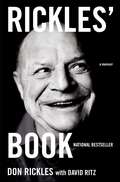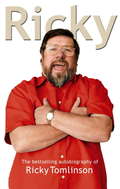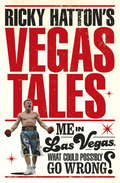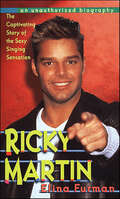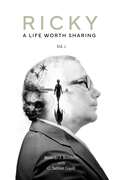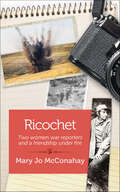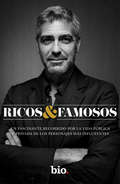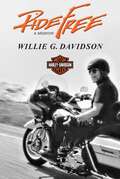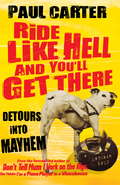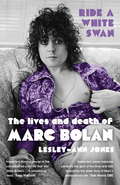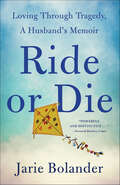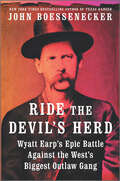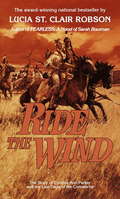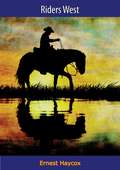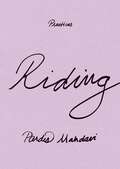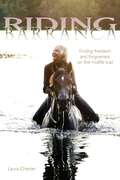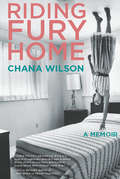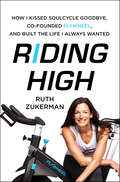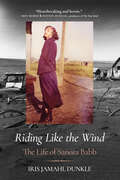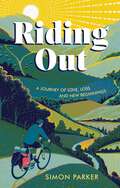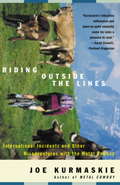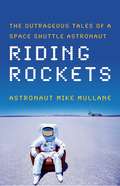- Table View
- List View
Rickles' Book
by David Ritz Don RicklesWhy you need to buy RICKLES' Book immediately: RICKLES' BOOK will help you win friends and influence people. RICKLES' BOOK will introduce you to all of his famous friends, from Frank Sinatra to Johnny Carson. RICKLES' BOOK will help you lose weight. RICKLES' BOOK will help you gain weight. RICKLES' BOOK will improve your love life. RICKLES' BOOK will make you cry. (If your love life doesn't improve.) RICKLES' BOOK will make you laugh. (If your love life does improve.) RICKLES' BOOK will make you love one of the great Americans of our time, Don Rickles. RICKLES' BOOK will give you something to talk about at parties. (If you're ever invited to parties.) RICKLES' BOOK, along with the Bible and War and Peace, will grace your bookshelf and upgrade your literary status. RICKLES' BOOK will keep you up at night. RICKLES' BOOK will put you to sleep at night. RICKLES' BOOK will make you rich. (If you treasure great humor.)
Ricky
by Ricky TomlinsonI know that I'm going to get stick over this book, but there you go - it can't be helped. And some readers might think I'm a terrible liar when they read what follows, but everything in this book is true. Enough lies have been told about me, without me adding to them.' Famous as the lovable couch potato Jim Royle of The Royle Family, Ricky Tomlinson has entertained millions without ever leaving his armchair. Now, in his long-awaited autobiography, he surprises yet again with a remarkable story of love, hardship, humour, injustice and triumph. His mother used to tell him that he had lived three lives, but even she miscounted. He has been a plasterer, banjo player, stand-up comic, union agitator, political activist, film extra, award-winning actor and unwilling guest of Her Majesty's prison service. Renowned and respected for his honesty, wit and integrity, Ricky brings all of these qualities to his extraordinary, moving and inspiring story.
Ricky Hatton's Vegas Tales
by Ricky HattonRicky Hatton's brilliance as a boxer, his down-to-earth demeanour and his live-wire sense of humour have made him a national treasure. Five of Ricky's biggest and most explosive fights took place in the boxing Mecca of Las Vegas. Tens of thousands of British fans followed him there to watch these monumental bouts, and to soak up the unique atmosphere in Sin City. In Ricky's Hatton's Vegas Tales, he recalls the most memorable moments: from fight negotiations, through trash-talking transatlantic promotional tours, gruelling training camps, bizarre encounters with opponents, fans, A-list celebrities and boxing legends; all the way to fight-week mayhem and the epic post-fight benders that followed. With contributions from family, friends and the journalists who know him best, tributes from Mexican boxing legends Oscar De La Hoya and Marco Antonio Barrera, plus the hilarious recollections of rock 'n' roll superstar Noel Gallagher, this is an anecdote-driven romp through all the highs and lows of Ricky's Vegas fights, and the madness that preceded and followed each bout. What goes down in Vegas, stays in Vegas... until now!
Ricky Hatton's Vegas Tales
by Ricky HattonRicky Hatton's brilliance as a boxer, his down-to-earth demeanour and his live-wire sense of humour have made him a national treasure.Five of Ricky's biggest and most explosive fights took place in the boxing Mecca of Las Vegas. Tens of thousands of British fans followed him there to watch these monumental bouts, and to soak up the unique atmosphere in Sin City.In Ricky's Hatton's Vegas Tales, he recalls the most memorable moments: from fight negotiations, through trash-talking transatlantic promotional tours, gruelling training camps, bizarre encounters with opponents, fans, A-list celebrities and boxing legends; all the way to fight-week mayhem and the epic post-fight benders that followed.With contributions from family, friends and the journalists who know him best, tributes from Mexican boxing legends Oscar De La Hoya and Marco Antonio Barrera, plus the hilarious recollections of rock 'n' roll superstar Noel Gallagher, this is an anecdote-driven romp through all the highs and lows of Ricky's Vegas fights, and the madness that preceded and followed each bout.What goes down in Vegas, stays in Vegas... until now!
Ricky Martin: An Unauthorized Biography
by Elina FurmanSmart, sexy, and soulful, Ricky Martin is more than a pop star. He's an accomplished actor and Grammy-award-winning singer who takes himself and his music seriously. Immensely talented, he started out young, acting in commercials at the age of six, and eventually joined the hugely successful singing group Menudo. In 1994 he joined the cast of the highly rated soap opera General Hospital and later landed the lead role in the smash Broadway musical Les Miserables, two career moves which would launch him into world-wide superstardom. From there, Ricky wanted to return to his first love, singing--and he did it with a bang, creating two multi-platinum solo albums, which won him a Grammy for Best Latin Pop Performance.What's next for this gifted heartthrob? With show-stopping good looks, talent to spare, and ambition to burn, the sky seems to be the limit. Find out about the man behind the image...discover what this cute crooner has said about his success, love, and music...learn about the real Ricky Martin--you'll be glad you did!
Ricky: A Life Worth Sharing, Volume I
by Ricardo J. Bordallo C. Sablan GaultBefore he was a businessman, senator, and governor, Ricardo J. Bordallo was simply “Ricky,” a young CHamoru man from Guam, the island he loved. The first volume of a two-part series, Ricky: A Life Worth Sharing is Bordallo’s account of his early life, as told to his cousin C. Sablan Gault. From an idyllic village childhood to the horrors of the occupation during WWII and the shifting cultural and political landscape of an island transformed in the aftermath of war, Ricky explores the formative experiences of one of Guam’s most well-known public figures.
Ricky: The Autobiography
by Ricky TomlinsonI know that I'm going to get stick over this book, but there you go - it can't be helped. And some readers might think I'm a terrible liar when they read what follows, but everything in this book is true. Enough lies have been told about me, without me adding to them.' Famous as the lovable couch potato Jim Royle of The Royle Family, Ricky Tomlinson has entertained millions without ever leaving his armchair. Now, in his long-awaited autobiography, he surprises yet again with a remarkable story of love, hardship, humour, injustice and triumph. His mother used to tell him that he had lived three lives, but even she miscounted. He has been a plasterer, banjo player, stand-up comic, union agitator, political activist, film extra, award-winning actor and unwilling guest of Her Majesty's prison service. Renowned and respected for his honesty, wit and integrity, Ricky brings all of these qualities to his extraordinary, moving and inspiring story.
Ricochet: Two war reporters and a friendship under fire
by Mary Jo McConahayA stunning memoir by California Book Award winner Mary Jo McConahay, from her years reporting for national magazines from Central America. When three colleagues die violently during a single wartime election day in Central America, two female journalists, best friends, are hurled into a torrent of change in their personal and professional lives and in their relationship with each other. The author, bedeviled by stress and feelings of abandonment, hangs on by her fingernails to reporting while her dear friend “just can’t take another picture of a dead body” and throws herself into teaching photography to children who live in a garbage dump. Big questions quietly roil their lives—What is our responsibility to history? To individuals?—until unexpectedly, they approach an answer together, when a child from the dump goes missing.
Ricos y famosos: Un fascinante recorrido por la vida pública y privada de personajes influyentes
by BioLos amores, los desamores, los celos, los escándalos sexuales, el alcohol, la cárcel, las drogas, las luces y las sombras de los famosos más seguidos del momento, contadas en exclusiva por BIO, el canal especializado en el mundo de las celebrities. George Clooney Penélope Cruz Chris Martin Giorgio Armani Angelina Jolie Mark Zuckerberg Michael Jackson Lance Armstrong Leonardo DiCaprio Whitney Houston Carolina Herrera Amy Winehouse Larry Page y Sergei Brin Tiger Woods Amancio Ortega Sean Penn Britney Spears Ray Crock Rafael Nadal Steve Jobs Un fascinante recorrido por la vida pública y privada de los personajes más influyentes. Provenientes del mundo del cine, la música, el deporte, la moda y los negocios, estas veinte personalidades del panorama internacional han luchado por llegar a lo más alto.Pero el camino hacia el éxito no siempre ha sido fácil y, para algunos de ellos, ha supuesto una caída posterior en las drogas, la enfermedad, la depresión e, incluso, la muerte. Contratos millonarios, éxitos sin precedentes, historias de superación personal, problemas con la justicia, romances e infidelidades... todo tiene cabida en un libro lleno de información exclusiva sobre las luces y las sombras de la fama internacional. Reunidos por BIO, el canal especializado en la crónica de vidas extraordinarias, Ricos y famosos recrea los aspectos menos conocidos de las vidas de un selecto elenco de personajes que se han convertido en hitos de nuestro tiempo.
Ride Free: A Memoir
by Willie G. DavidsonWillie G. Davidson likes to say that he was born with gasoline in his veins and a crayon in each hand. A designer at heart, Davidson combined his passions for art and motorcycles to extend a multi-generational unbroken thread from Harley-Davidson Motorcycle Company&’s birth in a wooden shed in the early twentieth century to today. The grandson of one of the company&’s founders and the son of one of its longtime presidents, Davidson created a series of iconic designs that defined Harley-Davidson &“factory custom&” bikes and cemented its standing as the premier motorcycle company in the world. Davidson was instrumental in saving the company from bankruptcy and then helping it explode into a global phenomenon. For more than five decades, Davidson was more than a namesake of the founders; he was the heart and soul of Harley-Davidson and a personal connection to millions of riders around the world who knew him simply as "Willie G." Throughout his life Davidson has embodied a close-to-the-customer relationship, by attending motorcycle rallies, rides, and races with his late wife, Nancy, the &“First Lady of Motorcycling,&” and son and daughter Bill and Karen Davidson who recently joined their famous parents by being inducted into the Sturgis Motorcycle Hall of Fame and play key roles in the Motor Company today. In Ride Free, Davidson recounts his memories of family, relationships, and events that defined his extraordinary life and legacy of power, passion, and purpose. Davidson gives readers a behind-the-scenes look at the planning, design, and conception of legendary bikes that inspired millions of riders over the past half-century; stories of his unforgettable rides around the world; the people he encountered while navigating thousands of miles on the roads; and the legacy that he and his family have created which will carry on the most famous name in motorcycles.
Ride Like Hell and You'll Get There: Detours into mayhem
by Paul CarterATTEMPTING 300KPH on an untested experimental motorcycle could be considered a perfect way to kill yourself, but Paul Carter is still, well, PAUL CARTER and danger at high speed is his second name. Whether discovering that being dyslexic means delivering your lines to camera back to front in the midst of filming a TV series, or starting a new business and travelling the world, or dealing with life's more sober moments like the birth of a son or the loss of a father, Paul Carter is still the funniest man in the bar and the nicest 'alpha male' you'll ever meet as he risks all for the sake of a cracking yarn. SO STRAP YOURSELF IN and HOLD ON TIGHT for his FOURTH BOOK - we just have to hope that he won't be institutionalised before completing his fifth!
Ride a White Swan: The Lives and Death of Marc Bolan
by Lesley-Ann Jones*** By the Sunday Times bestselling author of BOHEMIAN RHAPSODY ***From mod folk artist to flower power pixie elfin to the king of glam rockers, Marc Bolan was the ultimate chameleon. His far-reaching musical and stylistic influence is more relevant today than ever with hits such as 'Ride A White Swan', 'Children Of The Revolution', 'Get It On' and 'Hot Love' as fresh and exhilarating as when first released. At the peak of his popularity during his lifetime Bolan was outselling Jimi Hendrix and The Who, and yet relatively little is really known about the hypnotic, enigmatic 20th century boy turned 21st century icon. At last, in the 35th anniversary year of his tragic death, Marc Bolan represents the definite biography. Here rock biographer, Lesley-Ann Jones, paints a meticulous portrait of the T-Rex front man. From his childhood growing up in Hackney to his untimely death at the age of 29, Bolan's life was one of relentless experimentation and metamorphoses. Hallucinogenic drugs, wizardry and levitation, alcoholism, tax evasion and a spectacular fall from grace were to punctuate his short life, as he continued to strive to reinvent himself and his music over and over again. Lesley-Ann has been granted access to those who knew Bolan best, including his partner and the mother of his only son, Gloria Jones and his brother, Harry Feld.
Ride or Die: Loving Through Tragedy, A Husband's Memoir
by Jarie BolanderModern society has a warped sense of the partner-caregiver role, especially for men. Too often, men are ill equipped to handle switching from provider to caregiver, and the “just suck it up” advice so many offer up falls as flat as the Kansas prairie in the face of the reality of life and death.Ride or Die takes its audience through the intimate conversations and thoughts of a Gen-X latchkey-generation husband—a man who has always had to fend for himself and believed that it’s up to him to solve his own problems—as and after his wife, Jane, succumbs to a terminal disease.Jarie Bolander wrote this raw, heartfelt tribute to Jane and her handling of her illness to help men and the people who love them through the experience of loss and grief. A frank chronicle of how an intimate relationship can change and grow—even when the people involved feel there is nothing left to give—Ride or Die offers a detailed exploration of the male experience of grief, in the hopes that others suffering through it will not feel so alone.
Ride the Devil's Herd: Wyatt Earp's Epic Battle Against the West's Biggest Outlaw Gang
by John BoesseneckerThe story of how a young Wyatt Earp and his brothers defeated the Old West’s biggest outlaw gang, by the New York Times–bestselling author of Texas Ranger.Wyatt Earp is regarded as the most famous lawman of the Old West, best known for his role in the Gunfight at the O.K. Corral in Tombstone, Arizona. But the story of his two-year war with a band of outlaws known as the Cowboys has never been told in full.The Cowboys were the largest outlaw gang in the history of the American West. After battles with the law in Texas and New Mexico, they shifted their operations to Arizona. There, led by Curly Bill Brocius, they ruled the border, robbing, rustling, smuggling and killing with impunity until they made the fatal mistake of tangling with the Earp brothers.Drawing on groundbreaking research into territorial and federal government records, John Boessenecker’s Ride the Devil’s Herd reveals a time and place in which homicide rates were fifty times higher than those today. The story still bears surprising relevance for contemporary America, involving hot-button issues such as gang violence, border security, unlawful immigration, the dangers of political propagandists parading as journalists, and the prosecution of police officers for carrying out their official duties. Wyatt Earp saw it all in Tombstone.Praise for Ride the Devil’s HerdA Pim County Public Library Southwest Books of the Year 2021A True West Reader’s Choice for Best 2020 Western NonfictionWinner of the Best Book Award by the Wild West History Association“A marvelous book. By means of meticulous research and splendid writing John Boessenecker has managed to do something never before attempted or accomplished, tying together the many violent clashes between lawmen and outlaws in the American southwest of the 1870-1890 period and showing how depredations by loosely organized gangs of outlaws actually threatened “Manifest Destiny” and the successful taming of the Wild West.” —Robert K. DeArment, author and historian“A ripsnortin’ ramble across the bloodstained Arizona desert with Wyatt Earp and company. . . . Boessenecker displays a fine eye for period detail. . . . A pleasure for thoughtful fans of Old West history, revisionist without being iconoclastic.” —Kirkus Reviews
Ride the Wind: The Story of Cynthia Ann Parker and the Last Days of the Comanche
by Lucia St RobsonIn 1836, when she was nine years old, Cynthia Ann Parker was kidnapped by Comanche Indians. This is the story of how she grew up with them, mastered their ways, married one of their leaders, and became, in every way, a Comanche woman. It is also the story of a proud and innocent people whose lives pulsed with the very heartbeat of the land. It is the story of a way of life that is gone forever.
Rider of the Pale Horse: A Memoir of Los Alamos and Beyond
by McAllister HullA scientist's recollection of his life as a junior member of the Manhattan Project, Rider of the Pale Horse recounts McAllister Hull's involvement in various nuclear-related enterprises during and after World War II. Fresh from a summer job working with explosives in the chemistry department of an ordnance plant, Hull was drafted in 1943, after his freshman year in college. Unlike other accounts written by scientists and historians of that era, Hull's narrative offers a realistic picture of the dangerous and messy job that GIs and civilian powder men were asked to do. Life in the workshops where bomb components were constructed was very different from life in the offices where they were designed. Hull's description of his postwar work supporting the Bikini Atoll tests in the Pacific and the early concerns about the effects of a hydrogen bomb explosion illuminate the Dark Age of nuclear weaponry. John Hull's handsome illustrations show technicians and scientists at work and bring the story to life. Rider of the Pale Horse adds valuably to the total record of the most important technological development of the twentieth century.--Richard Rhodes, author of The Making of the Atom Bomb Hull gives a bottom-up view as seen by a foot-soldier. His account of the grubby details of the project is illuminated by his later view of its historical repercussions and bears new witness to a turning-point of history.--Freeman Dyson, author of Disturbing the Universe
Riders West
by Ernest HaycoxA MAN ON THE PROD—A RANGE AT WARNeel St. Could, forced by his vendetta with Dan Bellew, had a plan to turn the peaceful valley into an outlaw strip ruled by flaming guns.First he put his own crooked sheriff into office. Then he imported an army of gunslicks, took over Trail City and burned out the nesters. With the remaining spreads isolated, St. Cloud made his move.And on a storm-lashed night a hundred guns fought it out—with St. Cloud and Dan Bellew clashing head-on in their own personal battle.“Fast and Breathless”—New York Times
Riding (Practices)
by Pardis MahdaviIn Riding, Pardis Mahdavi meditates on the lessons learned over a lifetime of horseback riding and the falling, failing, and joy it brings. At once a history of Caspian horses, an exploration of Mahdavi’s Iranian-American identity and family history, and a consideration of the capacity for self-reflection and self-compassion through human-animal relationships, Riding offers a roadmap for learning to live in harmony with the self and the environment around us. Mahdavi shows how her relationship with horses gives her insights into intergenerational strength and tools for healing intergenerational trauma. Riding from the mountains of Iran to the beaches of California, Mahdavi shares her love affair with horses, rediscovers a homeland she longs for, and ultimately finds her strength.
Riding Barranca
by Laura ChesterIn this remarkable one-year journal, skilled horsewoman and adventurer Laura Chester brings us into her world, where we deeply connect with the earth and its seasons, with beauty and sometimes danger.While riding in places as far-reaching as Mexico, Australia, and India, Chester is always grateful to come home to the comforts of her familiar horse. As they cover the borderland of Arizona and the hills of Massachusetts, we get to know Barranca as intimate companion, mediator between soul and nature, whether entering the wilds of Cochise Stronghold or picking Berkshire apples from the saddle.Carried along on waves of memory, released by the gaits of her smooth-moving fox trotter, this literary memoir takes us on a personal exploration as well — where family relationships are fractured by anger, jealousy, illness, and death. With the help of her big-hearted animal, Chester is able to retrieve the past and find forgiveness. For as she says—Riding Barranca puts me in the moment, which is where I want to live.
Riding Fury Home: A Memoir
by Chana WilsonIn 1958, when Chana Wilson was seven, her mother held a rifle to her head and pulled the trigger. The gun jammed and she was taken away to a mental hospital. On her return, Chana became the caretaker of her heavily medicated, suicidal mother. It would be many years before she learned the secret of her mother’s anguish: her love affair with another married woman, and the psychiatric treatment aimed at curing her of her lesbianism. Riding Fury Homespans forty years of the intense, complex relationship between Chana and her mother-the trauma of their early years together, the transformation and joy they found when they both came out in the 1970s, and the deep bond that grew between them. From the intolerance of the '50s to the exhilaration of the women’s movement of the '70s and beyond, the book traces the profound ways in which their two lives were impacted by the social landscape of their time. Exquisitely written and devastatingly honest,Riding Fury Homeis a shattering account of one family’s struggle against homophobia and mental illness-and a powerful story of healing, forgiveness, and redemption.
Riding High: How I Kissed SoulCycle Goodbye, Co-Founded Flywheel, and Built the Life I Always Wanted
by Ruth ZukermanFrom the co-founder of Flywheel and SoulCycle comes Riding High, a story of perseverance and success.“Ruth Zukerman is an inspiration. She somehow had a keen sense that indoor cycling was going to be a huge trend and she wasted no time turning it into a lucrative business. I'm among the legions of Flywheel fans who make Ruth's class part of our regular routine. Her energy, enthusiasm and great playlist keeps us spinning and coming back for more." —KATIE COURICRuth Zukerman is the Queen of Spinning: she put the Soul in SoulCycle and the Fly in Flywheel.Recounting the pivotal moments that helped launch Zukerman as the breakout star of the boutique fitness world, Riding High is a reminder that the greatest success stories often start in the unlikeliest of places.Ruth Zukerman used her heartache–at the death of her father, the end of her marriage, and the dissolution of her first business partnership with SoulCycle, as the inspiration to reinvent herself. At 51, she co-founded a new business, the highly successful Flywheel, and built the life she’d always dreamed of. And she did it all while navigating through single motherhood and a business world that is often unkind to women, especially those who wear their hearts on their sleeves. Riding High is a prescriptive, warts-and-all journey through Ruth’s evolution, offering fresh, unexpected business and life lessons to help readers recognize their own potential and channel their passion into success. Part confidante, part mentor, Ruth pulls no punches and holds nothing back.
Riding Like the Wind: The Life of Sanora Babb
by Iris Jamahl DunkleThis saga of a writer done dirty resurrects the silenced voice of Sanora Babb, peerless author of midcentury American literature. In 1939, when John Steinbeck's The Grapes of Wrath was published, it became an instant bestseller and a prevailing narrative in the nation's collective imagination of the era. But it also stopped the publication of another important novel, silencing a gifted writer who was more intimately connected to the true experiences of Dust Bowl migrants. In Riding Like the Wind, renowned biographer Iris Jamahl Dunkle revives the groundbreaking voice of Sanora Babb. Dunkle follows Babb from her impoverished childhood in eastern Colorado to California. There, she befriended the era's literati, including Ray Bradbury and Ralph Ellison; entered into an illegal marriage; and was blacklisted by the House Un-American Activities Committee. It was Babb's field notes and oral histories of migrant farmworkers that Steinbeck relied on to write his novel. But this is not merely a saga of literary usurping; on her own merits, Babb's impact was profound. Her life and work feature heavily in Ken Burns's award-winning documentary The Dust Bowl and inspired Kristin Hannah in her bestseller The Four Winds. Riding Like the Wind reminds us with fresh awareness that the stories we know—and who tells them—can change the way we remember history.
Riding Out: A Journey of Love, Loss and New Beginnings
by Simon Parker"A truly inspiring journey that celebrates the healing power of adventure. A must-read." - Levison WoodThe remarkable and inspirational true story of how one man battled grief and anxiety, one pedal stroke at a time, on a 3,500-mile adventure around BritainIn March 2020, as Britain entered its first lockdown, Simon Parker's life fell apart; his travel journalism career vanished overnight and shortly afterwards he received the tragic news that a close friend had died. With a long-suppressed anxiety disorder starting to rear its head, he turned to the only therapies he knew and trusted: travel and exercise.Setting off on his bike from the northernmost point of Shetland with only a sleeping bag and a camping stove, Simon would end up cycling 3,427 miles around Britain. En route, he would meet hundreds of resilient Britons, who were all, in their own way, riding out the storm just like he was. Even in his gloomiest moments he began to see that a chink of light was never too far away.Riding Out is a story of optimism and hope, and a ground-level portrait of Britain as it transforms from a country in crisis to a nation on the mend. From Shetland to the Scillies, Dover to Durness, Simon learns that life's sharpest corners are best navigated at the gentle pace of a bicycle.
Riding Outside the Lines: International Incidents and Other Misadventures with the Metal Cowboy
by Joe KurmaskieLike a modern-day Don Quixote, Joe Kurmaskie--bike adventurer, writer, and twelve-year-old boy trapped in a man's body--wanders the world on two wheels, often with hilarious results, in Riding Outside the Lines. A jaunt through such far-flung locations as Ireland, Australia, Mexico, South America, and beyond, here is a collection of tales woven together with one central theme: the world is a much smaller place when you view it from the seat of a bicycle. Whether he's weekending in the buff after accidentally stumbling into a nudist colony wedding, knocking back red wine in tin cans with a gun-toting ex-bounty hunter, combing the countryside in a quest to find the all-girl bagpipe squad he met in his dreams, or playing a rousing game of ice golf on the frozen tundra, Joe Kurmaskie writes of his gonzo global trek in a spirit infused with insight, good humor, and optimism. Riding Outside the Lines encourages travel buffs and armchair explorers alike to get on your bike and see the beauty of our planet and the colorful souls who populate it.
Riding Rockets: The Outrageous Tales of a Space Shuttle Astronaut
by Mike MullaneOn February 1, 1978, the first group of space shuttle astronauts, twenty-nine men and six women, were introduced to the world. Among them would be history makers, including the first American woman and the first African American in space. This assembly of astronauts would carry NASA through the most tumultuous years of the space shuttle program. Four would die on Challenger. USAF Colonel Mike Mullane was a member of this astronaut class, and Riding Rockets is his story -- told with a candor never before seen in an astronaut's memoir. Mullane strips the heroic veneer from the astronaut corps and paints them as they are -- human. His tales of arrested development among military flyboys working with feminist pioneers and post-doc scientists are sometimes bawdy, often hilarious, and always entertaining. Mullane vividly portrays every aspect of the astronaut experience -- from telling a female technician which urine-collection condom size is a fit; to walking along a Florida beach in a last, tearful goodbye with a spouse; to a wild, intoxicating, terrifying ride into space; to hearing "Taps" played over a friend's grave. Mullane is brutally honest in his criticism of a NASA leadership whose bungling would precipitate the Challenger disaster. Riding Rockets is a story of life in all its fateful uncertainty, of the impact of a family tragedy on a nine-year-old boy, of the revelatory effect of a machine called Sputnik, and of the life-steering powers of lust, love, and marriage. It is a story of the human experience that will resonate long after the call of "Wheel stop."
